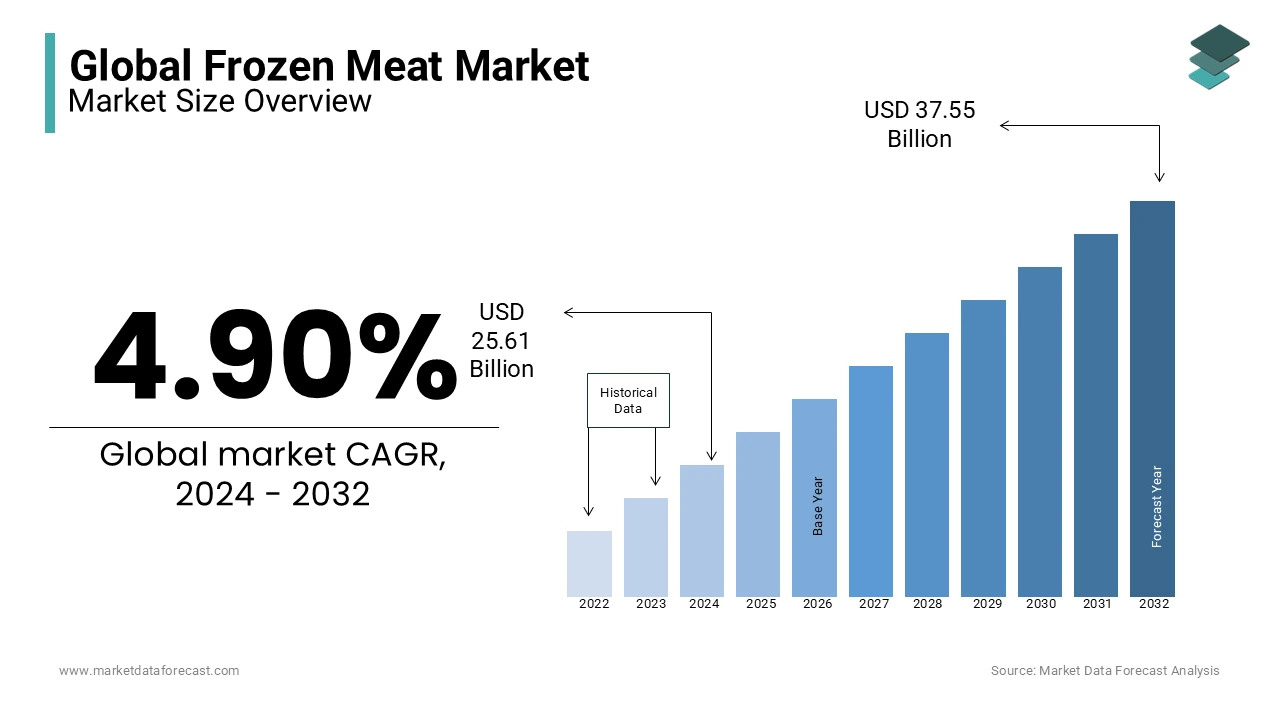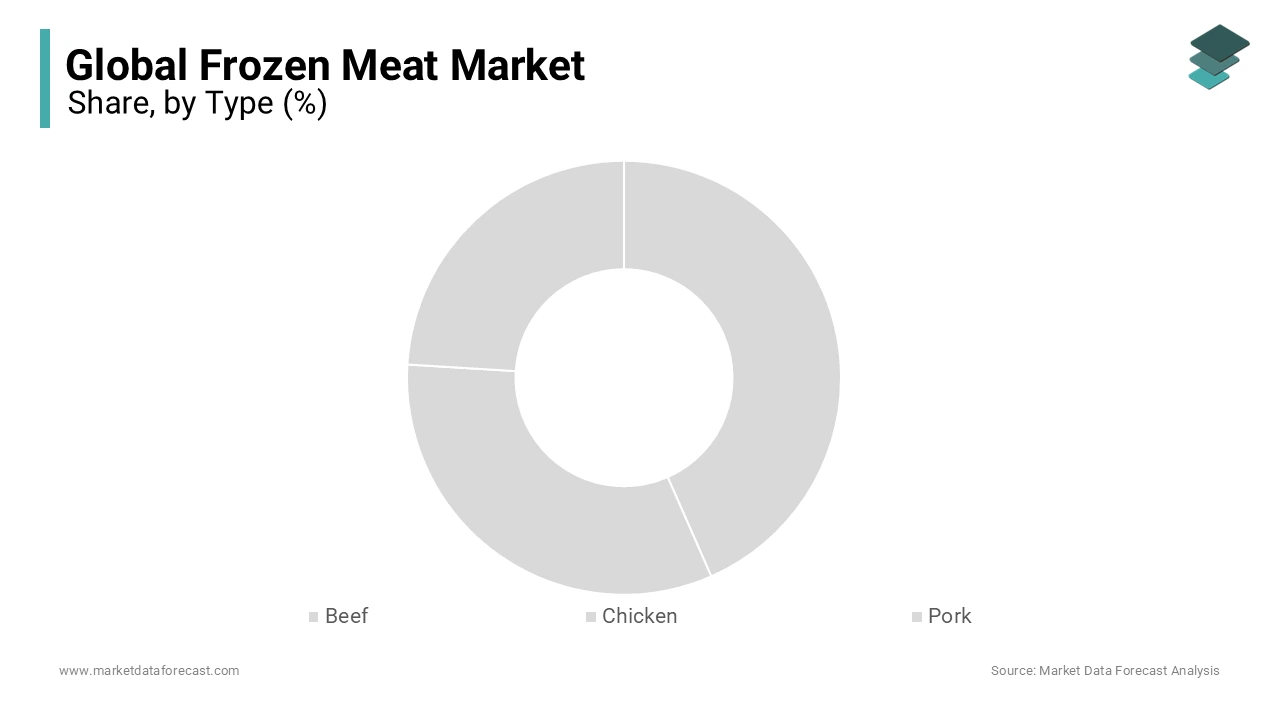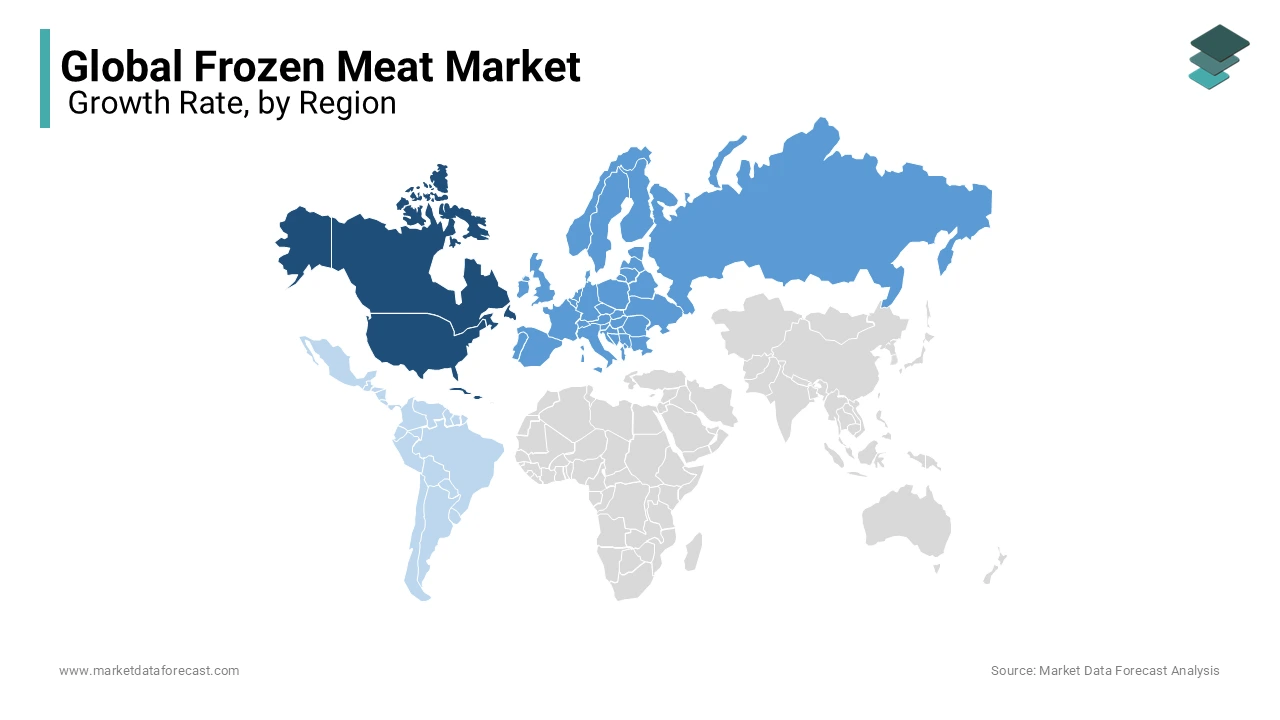Global Frozen Meat Market Size, Share, Trends, & Growth Forecast Report - Segmented By Product Type (Pork, Beef, And Chicken), End-User (Food Service, Retail Customers), Distribution Channel (Supermarket & Hypermarket, Convenience Stores And Online), And Region (North America, Europe, APAC, Latin America, Middle East And Africa) – Industry Analysis (2025 To 2033)
Global Frozen Meat Market Size
The size of the global frozen meat market was valued at USD 25.61 billion in 2024. The global market is predicted is grow at a CAGR of 4.90% from 2025 to 2033 and be worth USD 39.38 billion by 2033 from USD 26.86 billion in 2025.

Frozen meat with cold air or other cooling agents is primarily called frozen meat. Frozen meat is mainly drizzled with preservatives that can prevent food preservatives and extend shelf life. Frozen meat is the best way to overcome seasonal problems and has a long shelf life and long shelf life. Also, frozen meat products reduce food waste and are easy to cook. It offers a variety of benefits, including longer shelf life and food security, and is expected to drive growth in the global frozen meat market during the forecast period. Frozen food includes basic food chemistry, where food is preserved through the freezing process and stored in the freezer before cooking. Frozen foods can be of various types, such as prepared foods, meats and poultry, vegetables and fruits, soups, seafood, and others. Frozen meat improves inventory management, overcomes seasonality issues, and extends shelf life for advanced purchasing and long-term storage. An important factor driving the growth of the frozen meat market is that it is ready-to-eat food in both developed and developing countries, and the demand for developing frozen technology is increasing.
MARKET DRIVERS
Changes in the lifestyles of people around the world and the increased demand for ready-to-eat food are key drivers of markets around the world.
An increase in the workforce, higher per capita income in developing countries, and higher demand for frozen foods are expected to accelerate growth in this market during the forecast period. The freezing action inhibits the growth of potentially harmful bacteria that cause food poisoning. These factors are expected to increase demand for frozen meat during the outlook period. Quick freezing preserves the texture, flavor, and freshness of food. When there is little water, it turns into ice crystals, fixing freshness and nutritional value. Convenience trends and lifestyle changes have led to rapid growth in prepared food sales due to the development of dietary patterns and increased consumer consumption habits. Technological developments to improve the shelf life of products and rising efforts to offer quality products, especially meat-related products, are promoting the expansion in this market. As population migration from rural areas to large cities increases, the growth of the nuclear family in developed countries is expected to boost demand for frozen meat in the next decade. Also, the growing population of women working in developing countries is one of the main factors driving sales of frozen meat.
The retail industry has seen significant growth in the past decade and the trend is likely to continue in the coming years and fuel the growth of the global frozen meat market.
The frozen meat market offers a favorable opportunity in the retail industry. Certain meat products are offered only at certain stations. To meet the demand for meat products and overcome seasonality issues, manufacturers are focusing on introducing different types of frozen foods in this category. The market is gaining popularity, especially among young professionals, due to the aspects that consumers can easily consume and save time on products. In recent years, stable economic growth associated with the development of the mining industry has increased the number of employment opportunities, which has increased the average income of consumers. Furthermore, rising per capita income levels in developing countries, especially the growing demand for frozen food in the workforce, are other key factors expected to accelerate the growth of the frozen meat market worldwide during the forecast period. In developed and developing countries, the need to be ready to eat and change lifestyles is one of the main drivers of the global frozen meat market.
MARKET RESTRAINTS
Frozen foods contain various types of preservatives that can affect the body, which is another important factor that is expected to hinder the growth of the frozen meat market worldwide during the foreseen period. Frozen meat often turns out to be expensive, which can lead to more expensive food for end users. In this way, the high cost of frozen meat processing has significantly hampered the frozen meat market worldwide, and these costs can discourage potential customers from considering other options. The high cost associated with purchasing refrigeration equipment is an important factor in inhibiting the growth of the frozen meat market worldwide. Many companies are introducing cost-effective processing technology that can offset most of the constraints that affect the frozen meat market worldwide.
MARKET OPPORTUNITIES
The prominence of frozen meat will substantially increase in the coming years with the substantially rising demand for food consumption. The global population is raising concerns about food insecurity that will arise in the coming years. These concerns will propagate the demand for frozen meat in the future period. The latest technological developments in the food and beverage industry are gearing up the possibilities of launching new food products that have a long shelf life to avoid food wastage. About 52.4 million tonnes of bone-free, edible meat is being wasted while transporting or storing every year only due to a lack of proper knowledge of the benefits of the new technologies in the food industry. Similarly, according to the latest reports, on average, a person wastes 93 grams of food meat every single day. It is concerning that government bodies take serious action to avoid food wastage by quickly adopting new changes, especially freezing techniques.
The launch of various food delivery applications, where a person can easily order the desired food products that will be delivered to the doorstep, is projected to increase the growth rate of the frozen meat market during the forecast period. The number of people using food delivery applications is increasing day by day due to their growing popularity and easy delivery features at affordable prices.
MARKET CHALLENGES
The lack of proper infrastructure in the food and beverages industry, especially in undeveloped countries, makes it difficult to integrate the new technologies within to further produce high-quality products, which is acting as a big barrier to the growth rate of the frozen meat market key players. The lack of prominent support from government bodies, especially in emerging countries, is ascribed to impeding the growth rate of the frozen meat market. The traditional methods of producing frozen meat have many challenges like oxidation, purge loss, and product discoloration, which makes it very difficult for many small-scale industries to integrate advanced technologies. This factor will degrade the growth rate of the frozen market during the forecast period.
REPORT COVERAGE
|
REPORT METRIC |
DETAILS |
|
Market Size Available |
2024 to 2033 |
|
Base Year |
2024 |
|
Forecast Period |
2025 to 2033 |
|
CAGR |
4.90% |
|
Segments Covered |
By Type, Distribution Channel, And Region |
|
Various Analyses Covered |
Global, Regional and Country Level Analysis; Segment-Level Analysis; DROC; PESTLE Analysis; Porter’s Five Forces Analysis; Competitive Landscape; Analyst Overview of Investment Opportunities |
|
Regions Covered |
North America, Europe, APAC, Latin America, Middle East & Africa |
|
Market Leaders Profiled |
British Foods Plc, Kerry Group Plc, BRF SA, JBS SA, Verde Farms LLC, Pilgrim's Pride Corporation, Marfrig Global Foods SA, Tyson Foods, Inc., Cargill Inc., and VH Group |
SEGMENTAL ANALYSIS
Global Frozen Meat Market Analysis By Type

The frozen beef segment had 31.8% of the global market share in 2023 and is expected to continue to lead the market throughout the forecast period due to the high consumption and import of frozen meat from Asian countries and around the world. The beef sector is the fastest-growing sector during the forecast period, with pork and chicken expected to emerge. The demand for beef is expected to increase due to the higher protein content compared to other types of meat. The growing demand for pork is driving the market through the import and export of frozen meat.
Global Frozen Meat Market Analysis By Distribution Channel
The supermarket and hypermarket segment is expected to expand at the fastest CAGR in the worldwide market during the forecast period. Offline channels are driving the market, as consumers prefer the proper exploration of products, authenticity, content, and varieties before buying. However, as the penetration rate of smartphones and Internet connection increases, along with the convenience provided by the e-commerce platform, online distribution channels are gaining momentum among consumers. Online shopping trends are increasing among Internet users due to door-to-door delivery facilities and access to various brands and products.
REGIONAL ANALYSIS

North America held the major share of the global frozen meat market in 2023, and its dominance is expected to continue during the forecast period due to the high consumption of frozen food and increased disposable income in the region. Growing number of people living in the urban areas is subsequently prompting the growth rate of the market. People living in urban areas have busy work schedules, and their priority is to eat food that will be cooked in very little time. Increasing awareness of the importance of choosing the right food products that contain high nutritional value is accelerating the growth rate of the frozen meat market in the North American region. The US Department of Agriculture Food Safety and Inspection Services is taking stringent action against companies that only launch high-quality products that are free from microbes and other microorganisms that cause serious illnesses. Therefore, the companies are attributed to launching products with quality raw materials that are inclined to show positive growth opportunities for the frozen meat market in the US in the coming years.
The European market held the second leading share of the global market during the forecast period due to increased consumption of frozen meat and lifestyle changes. In Europe, Germany is expected to account for the largest share of the European market during the forecast period. Rising per capita income and growing prominence in eating high protein-based foods to stay active and healthy are gearing up the growth rate of the frozen meat market. Meat is a rich source of protein, and the rising demand from consumers for readily available meat products that have a longer shelf life and stay fresh for many months is likely to promote huge growth opportunities for the market.
The Asia Pacific market is expected to show the fastest growth in terms of revenue as the adoption of frozen foods increases. Asia Pacific was the largest regional market, representing more than 30.0% in 2018 due to the high consumption in this region. Countries like China and Japan were the main importers of frozen meat products. The Asia Pacific region is expected to expand to the highest CAGR from 2019 to 2025, and as the number of restaurants and food restaurants in the region increases, e-commerce growth and seasonal growth are expected to accelerate regional market growth. Chinese people usually consume huge amounts of food compared to other countries. Almost 100 million tons of meat are consumed every year in China, which is 27% of the total consumption of meat around the world. The growing consumer preference for staple food for meat is likely to outrage the growth rate of the market during the forecast period.
In addition, Latin American, Middle East, and African markets are expected to show moderate growth during the forecast period. In addition, imports from the Middle East and African markets are expected to register a notable annual rate during the envisioned period.
KEY PLAYERS IN THE GLOBAL FROZEN MEAT MARKET
Major Key Players in the Global Frozen Meat Market are Associated British Foods Plc, Kerry Group Plc, BRF SA, JBS SA, Verde Farms LLC, Pilgrim's Pride Corporation, Marfrig Global Foods SA, Tyson Foods, Inc., Cargill Inc., and VH Group
RECENT HAPPENINGS IN THE MARKET
- In 2017, Verde Farms LLC acquired Estanica Beef, Inc., a fully-fed beef producer serving frozen beef steaks. This acquisition will allow Verde Farms to meet the growing demand for grass-fed beef.
- Cargill, Inc. acquired Five Star Custom Foods, Ltd., which produces cooked meat flakes, soups, and sauces for American restaurants and food producers.
DETAILED SEGMENTATION OF GLOBAL FROZEN MEAT MARKET INCLUDED IN THIS REPORT
This research report on the global frozen meat market has been segmented and sub-segmented based on type, distribution channel, & region.
By Type
- Beef
- Chicken
- Pork
By Distribution channel
- Convenience stores
- Supermarkets
- Hypermarkets
- Online
By Region
- North America
- Europe
- Asia Pacific
- Latin America
- Middle East and Africa
Frequently Asked Questions
1. What are the benefits of frozen meat?
The benefits of frozen meat are its extended shelf life, which allows it to be stored for longer periods without spoiling, and its Convenience, which allows for bulk purchases and storage, reducing the frequency of shopping trips.
2. How is frozen meat different from fresh meat?
The primary difference between frozen and fresh meat lies in their preservation methods. Fresh meat is sold refrigerated and has a shorter shelf life, typically a few days to a week, whereas frozen meat is stored at much lower temperatures, prolonging its shelf life for several months.
3. How long can frozen meat be safely stored?
The storage duration for frozen meat depends on various factors, such as the type of meat, packaging, and storage conditions. Properly frozen meat can be safely stored for several months to a year. It's essential to adhere to storage guidelines and use-by dates for optimal quality and safety.
Related Reports
Access the study in MULTIPLE FORMATS
Purchase options starting from $ 2500
Didn’t find what you’re looking for?
TALK TO OUR ANALYST TEAM
Need something within your budget?
NO WORRIES! WE GOT YOU COVERED!
Call us on: +1 888 702 9696 (U.S Toll Free)
Write to us: [email protected]